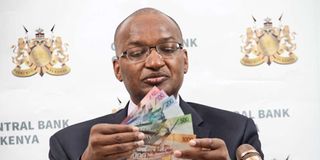
Central Bank of Kenya Governor Patrick Njoroge displays new notes on June 3, 2019.
What you need to know:
Governments of sovereign nations can never run out of money. Yes, this notion is based on an economic model known as Modern Monetary Theory (MMT) that is fast gaining attention worldwide.
In fact, a book on the same, titled The Deficit Myth released recently, is now on the list of New York's best sellers. MMT solutions are gaining traction because they are not only disruptive but also promise to get the global economy through the coronavirus crisis.
The theory is hinged on the philosophy that governments have a monopoly over their own currency meaning in principle, the government can never run out of money.
Central Banks can implement a Structured Money Creation System (printing or electronic) as a source of revenue. Yes, the government can make money out of thin air and inject it into its budget. Now the theory does not suggest a willy-nilly approach, no, it suggests a framework based around a structured system that has guidelines and related checks and balances.
Additionally, MMT further argues that governments' reliance on taxes for revenue is rather limiting leaving it with only debt options. Government debt is a sore spot. In Kenya, for instance, we now have about Sh3 trillion in foreign debt and another Sh3 trillion in local debt. Taxes no longer meet the speed of development. And in comes Modern Monetary Theory.
In money creation, the lens the government perceives budgets changes. The question of where to find money becomes the easiest question to answer. It now becomes what can we achieve, how do we achieve it, and so forth.
As with all models, there are risks and limitations, and so does MMT. There are two key restrictions namely, inflation and availability of resources.
Inflation
Excess money in an economy creates inflation but how much is too much? What if the Central Bank of Kenya (CBK) created Sh1 million ($ 100,000) every year. Will this cause hyperinflation? Maybe Sh100 million per year? Most will agree that figures under Sh100 million are inflationary averse but yet even this amount spread over 20 public and private children's homes could be a great boost.
More caregivers will be employed, more clothes will be purchased, more food will be bought, better sports and academic services will be offered. Therefore, rather than have a ceiling figure, we advise a project-by-project inflation rating.
We suggest that for each programme the government proposes, it must first undergo an inflation rating by the Federal Reserve. For argument sake, say out of 10 points with 10 being extremely inflation attractive and thus a safety cap of seven points is put in place.
Proposals of projects that score seven and above are returned to be amended. This way we handle the inflation question from inception.
Availability of resources
Rather than financial limitations, MMT helps the government focus on the real limits of resource availability (human capital, raw material, climate, technical expertise, and so on).
For example, a government can desire to construct a mega airport. No problem. The money can always be created and so the question that arises is do we local construction manpower in numbers? Do we have enough raw materials such as steel and concrete locally? Do we have spare manpower and machinery so as not to compete with other private sector projects and so on?
The new role of taxes
In such a model taxes then start becoming a tool to regulate inflation rather than one that is primarily the source of government revenue.
How does it regulate?
It works at the backend where in the event inflation numbers start to escalate the tax body levies higher taxes in that sub-sector which will reduce the amount of cash flow into the economy thus stemming inflation.
The tax money then is not returned back into the economy, instead, it's destroyed or donated as aid to foreign nations so as not to re-incur the rise in inflation these monies were warding off.
South Africa a donor nation, Hallelujah.
Foreign debt
Has the Sh3 trillion foreign debt caused hyperinflation? No. Therefore, the government could simply have printed the money rather than borrow seeing that there are no significant inflationary effects caused by monies coming from outside the economic cycles.
Our proposal
As a pilot programme we suggest the formation of a Revenue Replacement Grant Scheme as a key anti-corona stimulus programme for businesses of all levels. The grant can be processed digitally after businesses provide bank statements of their 2019 revenues.
The 2019 revenues can be approved and wired to them monthly for say two years. The scheme will be gradually phased off closer to the two-year mark and seeing it's a replacement plan we don't foresee inflation.
This means rather than retrenching, businesses can continue paying salaries and the economy will recover immediately. We need a new model for todays more pressing challenges and this is a viable candidate.
Mr Mwite is a director at Clark and Hampton Kenya and Out Of The Box Economists.




No comments :
Post a Comment